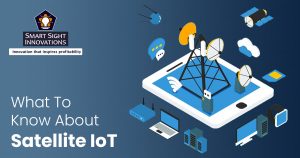 Having constant access to IoT services is crucial for anyone working in the utility, banking, retail, oil and gas, environmental monitoring or agricultural industries. However, there are instances when the business requires you to go to isolated, rural or hilly areas with spotty or nonexistent fixed lines or cellular service.
Having constant access to IoT services is crucial for anyone working in the utility, banking, retail, oil and gas, environmental monitoring or agricultural industries. However, there are instances when the business requires you to go to isolated, rural or hilly areas with spotty or nonexistent fixed lines or cellular service.
In addition to providing dependable backup for applications that are crucial to company operations, satellite IoT can assist in connecting these areas.
What Is Satellite IoT?
As the name suggests, this method of communication connects sensors and devices to the cloud using satellites. The first man-made communications satellite was put into orbit in 1960, and its primary function was to act as a massive reflector for messages traveling across the surface of the globe.
The strength and features of modern communications satellites have greatly improved. Satellite IoT is a service offered through satellite-based networks that allow devices to be connected so they may exchange information and convey commands without the need for human-to-human or even human-to-computer interaction.
This allows the automation of countless decisions and actions based on the data collected from remote devices. Satellite communication is crucial for IoT because of the extensive coverage it offers to devices that need to be connected.
A single satellite network can efficiently cover the whole earth. This suggests that while moving across the world, a single device can continue to use a single network and a single sort of connectivity.
Satellites have an advantage in remote areas where other communication methods like cellular or Wi-Fi have limited reach. It’s also the preferred mode of connecting IoT devices and in locations with weak or nonexistent infrastructure, like in the middle of the ocean. You can track and monitor containers and cargo through remote territories or even ships moving over oceans.
Satellite IoT also finds applications in research. Recorded data and information can be transmitted to research base stations with the help of scientific equipment and recording devices installed in areas that are inaccessible to humans, such as active volcanic vents, lighthouses in the ocean, weather balloons, etc.
Benefits of Satellite IoT
Here are some benefits of satellite IoT.
-
Merging Remote Assets
Businesses that operate in remote locations rely on satellites to provide critical communication infrastructure for monitoring remote facilities and real-time asset management at unmanned sites and offshore platforms.
-
Using Sensor Networks
Energy and mining corporations are looking into more broad employment of satellite-based sensor networks to support their offshore exploration initiatives.
-
Innovating Transportation Infrastructure
Broadband connectivity on trains, trucks and ships which is a growing trend in the world of transportation and satellite communications is essential for allowing cutting-edge mobility services.
-
Creating Sustainable Cities
Local authorities all over the world are using the IoT to push for energy-saving policies and more intelligent resource allocation to make cities more sustainable. For example, satellite technology is essential for extending smart sensors to remote areas where earthy networks are inadequate.
-
Supporting Retail and Mobile Banking
A satellite can act as the network infrastructure that keeps mobile point-of-sale applications and wireless ATMs operational over a wide area.
-
Reliability
Maintaining a high level of service consistency is always a fundamental prerequisite for successful IoT implementations, especially in an era of rising communications traffic. To ensure dependable, always-on access, carrier-integrated providers must collaborate with a satellite provider with a solid network that supports services like remote asset monitoring.
-
Widespread Coverage
The networking of intelligent gadgets will give rise to a brand-new generation of creative IoT applications. The potential scope of the IoT necessitates omnipresent network coverage between satellite operators and carrier-integrated services, even in remote places, given that billions of devices are anticipated to be involved globally.
-
Speed
Data transmission between connected things will be a key component of the future of IoT since it will speed up decision-making and improve company operations. As a result, the growth of IoT is increasing the demand for fast broadband, to enable real-time bandwidth-intensive applications. This will require considerable investments in portable satellite technology that can easily supply industry-leading broadband speeds.
-
Cost
Terrestrial networks can be expensive to set up in some distant areas and satellite IoTs are generally seen as a more cost-effective method of communication.
-
Integration
It is anticipated that the IoT will continue to increase demand for the use of satellites in communications. Carriers that offer technological integration must collaborate with satellite operators who can offer innovative equipment and adaptable satellite infrastructure that can be tailored to the requirements of their users.
Limitations of Satellite IoT
Satellite IoTs may have serious flaws such as latency and data limitations, which need to be worked on. These challenges vary depending on the provider as some persistent concerns with satellite services are being resolved by new technologies. Below are some limitations of the satellite IoT.
- In comparison to cellular networks, troubleshooting any system errors or hardware issues that may occur in satellite networks is quite challenging. Advanced knowledge of satellite and VSAT technology is needed to repair and maintain satellite IoT systems.
- Relaying messages from the earth’s surface to satellites and vice versa involves a 120–240 millisecond delay. Some satellite IoT applications may be impacted by poor latency.
- Rain, thunderstorms, hailstorms, blizzards and other inclement weather can disrupt satellite connectivity, lowering connection quality and increasing latency.
- Tree branches or buildings may obstruct signal transmission and can lead to the weakening of satellite signals. This is a significant issue in cities with plenty of towering buildings and high-voltage power cables.
- A limited supply of satellite connectivity compared to terrestrial networks may give users access to limited bandwidth, which is typically assigned based on plans. This makes satellite internet more expensive than other solutions.
These drawbacks have prompted the development of satellite IoT as a supplement to cellular IoT rather than a complete substitute for terrestrial IoT networks. Because of the most recent standards and configurations for satellite and cellular connectivity, the creation of integrated hybrid networks that combine the best aspects of both network types to maximize global connection is now possible. The same is being currently used where terrestrial networks are unavailable or cannot be built up.














